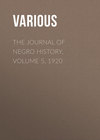Kitabı oku: «The Journal of Negro History, Volume 5, 1920»
The Journal of Negro History
Vol. V., No. 1 January, 1920
THE NEGRO IN EDUCATION 1
In the early history of America there were three types of settlements—the French, Spanish, and English. In the French Provinces the teachings of the "Code Noir" made it incumbent upon the masters to teach the slaves, at least to read, in order, of course, that they might read the Bible; and in the Spanish districts the Latin custom of miscegenation prevented the rise of objections to the teaching of slaves, in case there should be any who cared to instruct the Negroes. In the English Provinces, on the other hand, since teaching the slaves would probably result in their becoming Christians, the colonists naturally were strenuous in their efforts to prevent any enlightenment of the blacks, due to the existence of an unwritten law to the effect that no Christian might be held a slave. Many planters forbade the teaching of their slaves, until finally the Bishop of London settled the difficulty by issuing a formal declaration in which he stated that conversion did not work manumission.2
The rudimentary education of Negroes was one of the first claims on pioneer Christian teachers. Although the Negro Year Book for 1914-15 makes note of a public school for Indians and Negroes established in 1620, according to Brawley and Du Bois, the first schools to be established were private institutions.3 In New York City in 1704 a school was opened for Negroes and Indians by Elias Neau and in 1750 Anthony Benezet established an evening school for the blacks in Philadelphia. The Society for the Propagation of the Gospel established in Charleston in 1744 a mission school, in which two Negroes were employed to instruct their fellowmen. The free Negroes in Charleston established a school in 1774 and those in Boston started a school in 1798. In 1764 the editor of a paper in Williamsburg, Virginia, opened a school for Negroes and in 1800 a schoolhouse and 350 acres of ground were left by the will of Robert Pleasants to be used for the benefit of Negro children.4 About this same time in Newark, New Jersey, the Kosciusko School was established by means of a sum amounting to $13,000 left by Kosciusko for the education of the Negroes.5 In the Middle West private schools had been organized by manumitted Negroes.
St. Frances Academy, established in Baltimore in 1829, by The Colored Woman's Society, was the first school for colored girls. An institute for Negro children was established in 1837 in Cheyney, Pennsylvania, with the $10,000 left by Richard Humphries. By 1838 there were thirteen private schools in Philadelphia for the education of the Negro and in 1849 Avery College was established in Allegheny. Many of the schools were organized by church societies. The African Methodist Episcopal Church purchased in 1844 120 acres of land in Ohio upon which was opened the Union Seminary in 1847. This church later in co-operation with the Methodist Episcopal Church, North, established Wilberforce University in Ohio in 1856. Oberlin College in Ohio was opened in 1833 and Ashmun Institute, which later became Lincoln University, was established in 1854 in Pennsylvania. Nevertheless, there was in certain parts much opposition on the part of the citizens, evidenced by the mobbing of a young Quaker woman, Prudence Crandall, in Canterbury, Connecticut, in 1832, for having opened a school for Negro children; and in 1835 by the removal from the town of Noyes Academy in Canaan, New Hampshire, a school which had opened its doors to Negroes.
The efforts toward education for the Negro were disconnected and unorganized, while the laws opposing such education were fast increasing, so that the results seem very astonishing, despite the fact that so little was really accomplished. As early as 1740 South Carolina enacted a law forbidding the education of Negroes or the employment of slaves as scribes. Ohio in 1848 forbade Negroes and mulatoes to attend schools. Indiana enacted no law against Negro education but in 1850 omitted the Negroes from the school tax, which in turn resulted in their expulsion from education in that State. In 1852 Delaware enacted a law declaring the schools free for all white children over five years of age. In spite of all the regulations and severe laws opposing the education of the Negro many "clandestine schools" were held in Charleston, Savannah, and New Orleans before 1860.6 The private schools increased in number rapidly during the early nineteenth century among the free Negroes in the District of Columbia and the border States. They were less numerous in the South except in certain particular districts. In Washington, D.C., and New Orleans it is reported that at the opening of the Civil War there were about twenty schools for Negroes established.7 It is also estimated that in the slave States in 1860 there were 4,000 free Negro children in school.8 These figures, however, are relatively small in comparison with the numbers and economic standards of the free Negroes. In 1836 in New Orleans alone the freedmen numbered 855, owned 620 slaves, and held property whose assessed value equaled $2,462,470.9 By 1860 the total number of free Negroes was 487,970, or about one ninth of the entire black population;10 but the majority of these freedmen were in the rural districts, whereas the educational opportunities were in the cities, so that in 1863, with only 5 per cent of the Negro population literate the problem was indeed difficult, as far as the education of the black race was concerned.
The next period in the education of the Negro was a decade of the establishment of schools by the carpet-bag governments, mission societies, and the Freedmen's Bureau. Some of the schools established by the Negro carpet-baggers became very efficient. For example, in Florida, Jonathan C. Gibbs, a Negro graduate of Dartmouth, succeeded in founding in that State a splendid system of schools, which remained even after the fall of the carpet-bag governments.11 The American Missionary Association was the first benevolent organization to take up the work of education. The plan of this association was to establish one school of higher learning in each of the larger States in the South; normal and graded schools in the principal cities; and common and parochial schools in the smaller country places. As a result of this program, the principal institutions established were Hampton Institute, Atlanta University, Fisk University, Straight University, Talladega College, Tougaloo University, and Tillston College.12 The American Baptist Home Mission Society started work in 1862, which resulted in eight schools: Atlanta Baptist College and Virginia Union University for men; Spelman Seminary and Hartshorn Memorial College for women; and the coeducational institutions, Bishop College, Benedict College, Shaw University, and Jackson College.13 In 1866, just before the beginning of the work of the Freedmen's Bureau in education, the schools so far established had in attendance nearly 100,000.14 The Freedmen's Bureau had been established in 1865 by an act of Congress and by 1867 it reported 1,056 Negro teachers and in 1870 the number was increased to 1,342. During the five years of its work, this bureau established 4,239 schools in the South, with a total number of teachers of 9,307 and of students, 247,333.15 Howard University, established in 1867, was one of these institutions. The Freedman's Aid Society was organized by the northern Methodists in 1866 and to-day this society supports fifty institutions, ten of which are collegiate.16
At the end of this period many religious agencies were establishing schools. The Episcopalians established the St. Paul Normal and Industrial School at Lawrence, Virginia, and St. Augustine's in Raleigh, North Carolina. The Roman Catholics opened St. Joseph's Industrial School at Clayton, Delaware; St. Augustine's Academy and St. Frances' Academy. Besides these they have in the United States 87 schools for Negro children cared for by 24 sisterhoods.17 The African Methodist Episcopal Zion Church has established twelve institutions, four colleges, one theological school, and seven secondary schools.18 The Presbyterian Board of Missions has established Biddle University in North Carolina, five seminaries for girls, and 70 academies and parochial schools.19 The work of this period was not only constructive as far as Negro education was concerned, but it also affected the life of the white population as well by instituting public school systems in "regions where public schools had been unknown,"20 bringing about a new attitude in the South toward public schools in general, since the whites up to this time had, in the words of Colonel Richard P. Hallowell, "regarded the public school system in the North with contempt."21
Toward the end of this period a new type of education was introduced by the founding of Hampton Institute in 1875. This marked the beginning of the period of industrialism, the purpose of such education being to give the Negro children "combined mental, moral and industrial training."22 Following the founding of Hampton, Tuskegee Institute was established; also being an industrial school. With these two institutions as centers, the ideals of the industrial propagandist radiated in all directions, finally permeating the whole educational system, not only that of the Negro, but the educational system of the schools for white children as well.
Although separation of the black and white children in the public schools is forbidden in fourteen of the States, the law requires the separation of the children in the following States: Alabama, Arkansas, Delaware, South Carolina, Florida, Georgia, Kentucky, Louisiana, Maryland, Mississippi, North Carolina, Oklahoma, Tennessee, Texas, Virginia, and West Virginia. In Arizona, Indiana, Kansas, and Wyoming, the boards of education are given the power to decide the question. Eleven of the States of the Union make no provision in their laws one way or the other23 Separation is demanded in the private schools in Kentucky, Florida, Tennessee, and Oklahoma. The law in Kentucky was created at a time when it affected only one institution—that of Berea College, which was established in 1856 for the education of anti-slavery whites and was opened to Negro students after the Civil War. In 1904, the date of the passage of the law, this college had 927 students, 174 of whom were Negroes.24 All of the Northern States have compulsory education, but only two of the Southern States, Kentucky and Missouri, have enacted such laws. This does not mean, of course, that these laws are enforced, nor is this a key to the amount of education obtained in proportion to the population, but it does indicate the difference in opportunities for education between the Northern and Southern States.
In regard to the elementary education of the Negro children the whole situation is rather discouraging, but great progress has been made and one may hope for still greater progress in the future. The increase in facilities for education between 1866 and 1870 was quite marked, with a corresponding increase in the number of pupils, as shown by the following table:
Increase in Education From 1866 To 187025

The total expenditure for education during this period was $5,879,924. There was in 1870, however, only about one tenth of the Negro children of school age in school. Later, from 1889 to 1909, the number of children enrolled greatly increased:
Percentage of Persons 5 To 18 Years Enrolled26

In the first year more than half the children were in school, a decade later the increase was practically the same in the case of the Negro children as it was in the case of the white children, but nine years later the percentage had risen over 2 per cent in the case of the white children and had decreased in the case of the blacks. The census report of 1910 shows the percentage of Negro children enrolled in school to be but 47.3 per cent, a decrease of 9 per cent. The average attendance of the Negro children amounted to about one-third of the number enrolled.27 For these children there were 28,000 teachers, or in other words, one teacher to every group of 57 children; whereas the teachers for the white children averaged one to 45. The report of the Commissioner of Education in 1909 gives a total number of school children in the slave States of 3,054,888, instructed by 9,000 school teachers—3,114 males and 5,886 female.28 According to this report, there would only be one teacher to every group of 184.35 children. This seems an impossible number, so that one feels that surely something must be wrong with the report. The training of these school teachers is not of the highest, nor do they have a great deal of training. The State School Commissioner of Georgia gives the following report of conditions there:29

The expenditures for all the children equaled $46,000,000, but the Negro children who were one third of the total number received but one seventh of this sum. For 231,801 Negro children South Carolina spent $366,734.28, or $1.58 per capita, whereas Massachusetts spends $27 per capita each year, and the District of Columbia spends $35.21. The South Carolina school tax is heavier than the tax in Massachusetts, but this State spends only $3.82 per capita for white children.30 Louisiana spends 93 per cent of the school funds for the white children, and 7 per cent for the colored, making a per capita expenditure of $16.60 for the white children and for the Negro an expenditure of $1.59. The District of Columbia spends more for the colored children than for the white, per capita expenditure: white, $20.82; Negro, $21.87.31
The rural schools, as may be expected, are in a worse condition than those of the city, in regard to equipment, teachers, and especially in subject matter relating to the adjustments to a rural community. Nevertheless, it seems that there is much more progress being made in these schools than in those in the city. Baily in his Race Orthodoxy in the South describes a visit to what he terms a typical rural school.32 "There were no desks and only a small fragment of a blackboard in one corner. The teacher showed signs of having very little education himself and used no methods whatsoever in teaching. There was only one whole book for the entire reading class. The pupils came at all hours of the day and left whenever convenient for them. When the teacher was asked how many pupils were enrolled in the school, he answered that there were sixty." Mr. Bailey remarks that, after glancing over the room, he fancied there were sixty "acomin' and agoin'."
The Negroes in the rural communities have practically no literature with the possible exception of a few patent inside newspapers carried on by the heads of one or the other Negro orders.33 The amount of elevating reading matter may be judged by the type of advertisements which run along the line of "hair-dressing that makes kinky hair soft, pliant and glossy," and also of experiments of surgeons with the X-ray in making black skin white. Among the books furnished in the schools, nothing contained in them relates in any way to rural life.
In 1908 in North Carolina the average length of term for the rural Negro school was 82.1 days,—the average length for all Negro schools, including high schools, being 93 days. In this State there are 195 log schoolhouses and 2,216 of the Negro schoolhouses are furnished with home-made desks and benches. The rural Negro teacher receives an average salary of $22.48 per month and the city Negro teacher receives but $30.20.34 The conditions in the agricultural communities in the North seem to be better than those in the South. 20,700,000 ruralites in the South average 7,000,000 children of school age, 4,400,000 of whom are enrolled in school with an average attendance of 2,700,000. In the North, on the other hand, 20,700,000 ruralites average 6,000,000 children, 4,500,000 of whom are enrolled, with an average attendance of 3,200,000. For the South there are 92,000 school teachers, whereas there are 158,000 in the North. School property in the South is valued at $42,000,000 and in the North at $217,000,000. The school revenue is $26,000,000 and $92,000,000 respectively. Per capita expenditure in the South is under $10 and in the North it is almost $30. The South spends only 16 cents on each $100 valuation, and the North 20 cents.35
Many signs of progress are visible in the South, due mainly to the influence of industrial institute graduates who attempt to reorganize the rural districts with more or less success. One graduate of Tuskegee seems to have met with unusual success in Hinds County, Mississippi.36 The Negroes in this community outnumber the white population seven to one, but out of 40,000 of the inhabitants 13,000 can neither read nor write. In five years this graduate has built up an industrial school with a farm of 1,500 acres, three large and eleven small buildings, one large plantation house and thirty farm houses. The school property is valued at $75,000, and he has started an endowment fund in order to make the work permanent. In Macon County, Alabama, improvements have been rapid. In five years' time through the influence of a changed school system the value of the land has risen from $2 an acre to $15 and $20. It is reported that crime has been reduced to a negligible quantity. At the last sitting of the grand jury there were only 17 cases of all kinds.37 The "Rising Star" School in West Virginia through a change in teacher and curriculum has affected the community in as equally astonishing manner. Not only are the homes of the farmers improved, but the number of land-owning citizens has also increased. Even the religion preached has been greatly changed with the introduction of industrial training.38 There is one school fund which is for the purpose of improving rural conditions, that is the Jeanes Fund amounting to $1,000,000, the interest on which is to be used for the rural schools in supplying competent teachers as supervisors to introduce industrial training. The influence of this fund together with the influence of Hampton and Tuskegee Institutes seems to be the hope of the future for the rural districts.
In the matter of secondary education, high schools for the Negroes are practically lacking. In Atlanta with a Negro population of 51,902 Negroes; in Savannah with 33,246; and in Augusta with 18,344, there are no Negro high schools whatsoever.39 The following table shows the distribution of the 156 high schools for Negroes40 (1913):

The increase in the number of high schools in the Southern States from year to year is shown by the following:41

Apparently there is no effort in the South to supply high schools for the Negro. The General Assembly of Georgia passed a bill to establish high schools in all of the congressional districts of the State. Eleven were established and supported by a fertilizer tax, most of which was paid by the Negroes who numbered 45.1 per cent of the population of the State, and 80 per cent of whom lived in the rural districts. None of these schools, however, were for members of the Negro race.42
The founding of the two most important industrial schools has been mentioned before. Hampton Institute which was founded by the American Missionary Society in 1868 now consists of 113 buildings, including the instructors' cottages.43 76 of these buildings were erected by student labor. There are 120 acres to the Home Farm and 600 acres to Shellbanks, six miles from the Institute. The enrollment in 1910 was 875, or 1,399 including the Normal Practice School. Tuskegee Institute which began with one hoe and a blind mule now possesses 2,000 acres of land, 800 of which are cultivated each year by the young men of the school. During 1903, 33 trades were taught to over 1,400 men and women. By means of this work, the students pay more than one half of their expenses. Of the sixty buildings, all but four were almost wholly erected by students, even to the making of the bricks.44 Although the average Negro was greatly antagonistic regarding this training at the beginning of the work at these institutes and many protests were heard from all sides, Mr. Washington stated in The Negro Problem that it has been several years since they have received a protest from parents against teaching industrial training.45 The graduates of Tuskegee have established more than fifteen similar schools in the South.46 Among those established are Voorhees Industrial School, Robert Hungerford School, Snow Hill Normal and Industrial Institute, Topeka Normal and Industrial Institute, Port Royal Agricultural School, and Mt. Meigs Institute.
No one of the Negro institutions for higher learning has as yet become a fully equipped university. No one of the institutions maintains a graduate school. Howard University is the only one that has even started graduate work.47 The real influence of the college has been to prepare men to be leaders in education, as may be witnessed by the fact that out of the 5,000 Negro college graduates in the United States 54 per cent are teaching, while 20 per cent are preaching.48 The following table shows the number of college graduates by decades:49

The distribution of the college Negro is indicated in the following:50

103 of these graduates were born in the North, 65 or 63 per cent of whom remained in the North and 35 or 34 per cent migrated to the South; 682 of these were born in the South, 102 or 15 per cent of whom went to the North, and 563 or 82.5 per cent remained in the South. This shows that the tendency of the college graduate is to remain in the South where he is most needed.
Of the graduates of 107 colleges which are not Negro institutions 79.2 per cent or 549 have been men, and 20.8 per cent or 144 have been women. Of 2,964 graduates of 34 Negro colleges, 82.7 per cent have been men and 17.3 have been women.51 This difference may be due to a greater economic standard of the Negro in the North, since the colleges admitting Negroes which are not Negro institutions would be in the North, and to the fact that more Negroes would be located near educational institutions in the North than they would be in the South.
From another report the average age for the women graduates was 21-1/3 years, and the average for the men was 22-3/16 years. There seems to be a tendency of the age to increase, as shown by the following:52

Of the 24 graduates reported 16 were under 35, and one was over 50.
Of 799 graduates 67.3 per cent of the males were married, and 31.1 per cent of the females were married. Among these graduates there are only two cases of divorce, one man and one woman. The ages at which they married were for the men between 25 and 34 and for the women between 20 and 29. The families averaged four children. The death rate among the children has not equalled one child per family.53
Statistics taken in 1913 of 258 schools show the college students to be only 4.1 per cent of the entire number of Negroes in schools. If the college graduate were in proportion to the population their number would be about five times as great as it is at present.54
The Negroes have contributed in all lines to a large extent toward their own education. Since 1865 religious and philanthropic associations have contributed $57,000,000 and the Negroes by direct contributions have supplied $24,000,000.55 In 1869 in one year the Negroes raised $200,000 for the construction of school houses. A report from a State Superintendent of Schools of Florida stated that in the Black Belt Counties the Negro schools cost $19,457 and the direct and indirect contributions on the part of the Negroes amounted to $23,984. There were $4,527 remaining which was used for the benefit of the white schools.56 It is thought on the part of some that the Negro, although he may not pay in direct taxes a sum sufficient to provide for his schools, may in reality be paying his full share indirectly. I believe, however, that it is quite safe to say that he probably pays as much for his education as any other poor class of the population, especially so in comparison with some of the immigrant classes. There have also been quite a number of Negro philanthropists, the most prominent of whom have been Bishop Payne who gave several thousand dollars to Wilberforce, Wheeling Grant who gave $5,000 to Wilberforce, Mary E. Shaw who left $38,000 to Tuskegee, Nancy Addison who left $15,000 for education in Baltimore, Louis Bode who left $30,000 and George Washington of Jerseyville, Illinois, who left $15,000 for education. Thomy Lafon, of New Orleans, left $413,000 to be used for educational purposes with no distinction regarding race or color. Colonel John McKee, of Philadelphia, left about $1,000,000 in real estate to be used for education.57 The Negro Baptist Churches alone raised in 1907 $149,332.75.58 In nine years the Negro students paid in cash to 74 Negro institutions $3,358,667 and in work $1,828,602, making a total of $5,187,269. This amounted to 44.6 per cent of the entire running expenses of the institutions.59
The attitude of the Negro immediately after the war was that of opposition to all kinds of labor. He had not as then learned the distinction between working as a slave and working as a freedman. What he wanted most was an education, a literary education, such as the white man had. He did not want his education for any definite purpose, except as an end in itself. The chief reason probably may have been that of a desire to put himself on a par with the white man, and to prove his intellectual equality. The attitude to-day is radically different, being represented by men like Washington and DuBois. Washington preached the gospel of industrial education, believing strongly that that method would lead to an increase of the economic wealth of the race, whereby they could acquire the so-called higher education. DuBois, however, although he believed in the efficiency of industrial training, also felt that the race should not neglect to educate leaders even at the present time, so that his attitude differs from that of Washington in a slight degree. Two short quotations from Washington's writings may illustrate to a certain extent the attitude of the leaders of Negro education: "What Negro education needed most," said he, "was not so much more schools or different kinds of schools, as an educational policy and a school system,60 and "I want to see education as common as grass, and as free for all as sunshine and rain.61
Prejudice is an important factor in the attitude of the white race toward Negro education. This prejudice seems to be in all sections of the country, but it is the southerner who is heard from the most, possibly because he is more in contact with the real problem and then because it seems to be a policy of southern politicians to attempt to outdo each other in their speeches along the line of race prejudice. According to Weatherford prejudice has arisen out of the fear that education will lead to the dominance of the Negro in politics and to promiscuous mingling in social life. "The southern white man will never be enthusiastic for Negro education, until he is convinced that such education will not lead to either of these."62 This feeling of a group is expressed in the following statement in a report to the Baltimore Council by a committee in 1913: "No fault is found with the Negroes' ambitions," said the report, "but the Committee feels that Baltimoreans will be criminally negligent as to their future happiness, if they suffer the Negroes' ambitions to go unchecked."63 Mr. Thomas Dixon, Junior, deplores the fact that Washington was training the Negroes to be "masters of men," stating that "if there is one thing the southern white man cannot endure it is an educated Negro."64
School officials and educators on the other hand show an entirely different attitude. Mr. Glenn, recently Superintendent of Education of Georgia, made the declaration that "The Negro is … teachable and susceptible to the same kind of mental improvement characteristic to any other race."65 Thomas Nelson Page states that "the Negro may individually attain a fair and in uncommon instances a considerable degree of mental development."66 Another states that "We must educate him because ignorant men are dangerous, especially to a democracy pledged to educate all men."67 Some believe that we must also educate him for self-protection from vice and disease. The Southern Educational Association in 1907 passed the following resolution: "We endorse the accepted policy of the States of the South in providing educational facilities for the youth of the Negro race, believing that whatever the ultimate solution of this grievous problem may be, education must be an important factor in that solution."68
Illiteracy which in 1863 equaled about 95 per cent of the Negro population has been decreasing rapidly since the Civil War. The illiteracy of the Negro during the last three decades has been as follows: in 1890, 57.1 per cent; in 1900, 44.5 per cent; and in 1910, 30.4 per cent. In the North in 1910 the illiteracy was 18.2 per cent in the South 48.0 per cent, and in the West 13.1 per cent.69 The urban Negro in 1910 showed 17.6 per cent illiteracy and the rural 36.5 per cent. Louisiana showed 48 per cent, whereas Minnesota and Oregon showed only 3.4 per cent.70 In 1900 when the Negro illiteracy was 44.5 per cent, the children between ten and twenty-five years of age showed only 30 per cent and those between 10 and 14 years in Mississippi showed only 22 per cent.71 The illiteracy for all Negro children was 25 per cent, whereas the illiteracy for all white children was only 10.5 per cent.72 The illiteracy of our Negroes does not seem so great when a comparison is made with some foreign countries:73

The percentage of Negro illiteracy in America is less than any one of these foreign races.
The following articles have also been used: Henry E. Baker, The Negro in the Field of Invention (Journal of Negro History, January, 1917, p. 21); W. H. Baldwin, Jr., The Present Problem of Negro Education (American Journal of Social Science, 37, 1899, p. 52); W. E. Burghardt DuBois, The College Bred Negro (Atlanta University Publications, No. 15, Atlanta, 1910); The Common School and the Negro American (Atlanta University Publications, No. 16, 1911); The School (Atlanta University Publications, No. 14, 1909); Education and Crime Among Negroes (Review of Reviews, 55, 1917, p. 318); Hampton Negro Conference, Annual Report, July, 1899 (Hampton Institute Press, 1889); Higher Education of the Negro (The Nation, 100, 1915, p. 187); George Johnson, Education of the Negro (The Nation, 100, 1915, p. 443); Jesse Lawson, How to Solve the Race Problem (Report of the Washington Conference on the Race Problem in the United States, Washington, D. C., 1904); William Mathews, The Negro Intellect (North American Review, 149, 1889, p. 91); More Testimony on Negro Migration (Survey, July 14, 1917, p. 340); National League on Urban Conditions Among Negroes, Bulletin, Vol. V, No. 1, November, 1915; Michael E. Sadler, Education of the Colored Race (Great Britain Educational Department, Special Reports of, 1902, Volume II); Charles Dudley Warner, The Education of the Negro (American Journal of Social Science, 38, 1900, p. 1); Booker T. Washington, Fifty Years of Progress (Forum 55, 1916, pp. 269-79); Monroe N. Work, The Negro Year Book (Nashville, Sunday School Union Print, 1915).




















